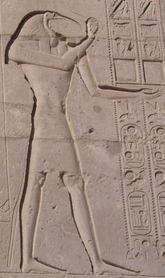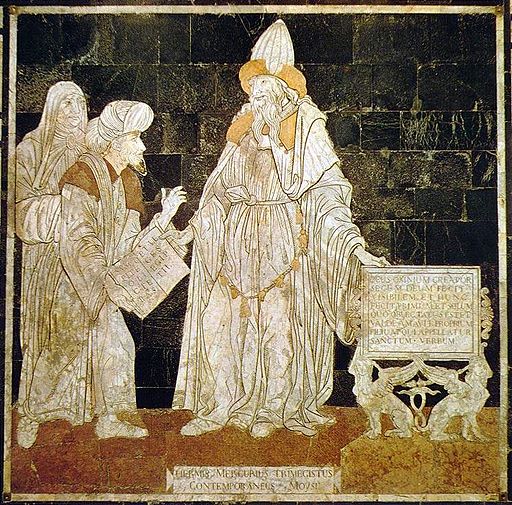Thoth

Ibis-headed depiction of Thoth
The Ancient Egyptian god Thoth, a god of writing, wisdom, and hidden knowledge, was often shown as a type of bird called an ibis, or as a man with the head of an ibis (he might also be depicted as a baboon). Ibises were common along the banks of the Nile in Ancient Egypt, but are not confined to that region. While you may not see them every day, this type of bird is not uncommon in Southeast Louisiana. You can imagine my delight, as an Egyptologist who had seen images of Thoth enumerable times, at happening past this flock of ibises one day in City Park. It was the very first time that I saw this type of bird up close and in person.

Krewe of Thoth riding in the 1990s
If you live in New Orleans or have spent much time here, you are undoubtedly familiar with the Krewe of Thoth (see glossary below), whose parade rides the Sunday before Mardi Gras Day and has become a major event during Carnival Season. Founded in 1947, the Krewe of Thoth is unlike any other krewe in two respects: first, the krewe organizes a variety of events not only during Carnival, but also throughout the year; second, Thoth plans its route to pass by several institutions where people with disabilities and illnesses live, bringing a piece of Mardi Gras to those who are usually unable to attend parades. Because of this second feature of the parade, Thoth has sometimes been called “The Krewe of Shut-Ins.” The Krewe of Thoth is also known for its elaborate throws, including specialized doubloons, stuffed animals, and 3-D die-cut beads related to the parade’s theme.
Histories of the Krewe of Thoth generally do not specify why the krewe chose to name itself after this ancient deity. However, it is a fitting choice for its name, since Thoth was a divine physician, caring for other deities, while the Krewe of Thoth still focuses on bringing Mardi Gras to people whose ailments would otherwise keep them from being able to attend a parade. Just as the Krewe of Thoth is an important and very popular parade during Carnival (but is not the crowning parade of Mardi Gras Day) so too the ancient deity for which it is named was pivotal in the ancient Egyptian pantheon, though he was generally (with some exceptions) not considered a supreme, creator deity.

Thoth recording years of the king
In addition to his role as divine physician, in which he healed prominent deities such as Isis and Horus, Thoth had many other characteristics. He was a mediator between the rivals Horus and Seth, setting an example of an impartial judge and incorruptible administrator. As the god of writing, it was Thoth’s responsibility to record all events, happenings, and laws and sometimes even to enforce those laws and uphold the Egyptian ideal of ma’at (divine order, right, truth). Thoth also played a role in everyone’s afterlife, providing (depending on the source) a means of transportation to the heavens, a safe haven while passing demons of the underworld, or assistance in pleading one’s case at the time of judgment.
The Ancient Greeks associated Thoth with their god Hermes, who was the messenger of the gods and an intercessor between humans and the divine. During the fifteenth century in Renaissance Italy, Thoth received renewed interest in his form of Hermes Trismegistus (Thoth-Hermes the Thrice Great, a name probably derived from Thoth’s Egyptian epithet “the great great great”) as part of the larger revival of Classical literature and science. The body of literature known as the Hermetica was attributed to Hermes Trismegistus, who was said to have been a great thinker who lived thousands of years ago and was a kind of prophet who preceded Christianity, rather than a deity from pre-Christian tradition.
The Hermetica had a profound influence on alchemy (through which the term “hermetic seal” originates), culture, and thought at the time, with its impact continuing as late as the seventeenth century. The Hermetica’s influence was not confined to the Judeo-Christian world, though, as it also holds a place in Islamic tradition. In reality, the texts in the Hermetica were likely written by a variety of authors during the last few centuries B. C. E. and the early centuries C. E., and were perhaps heavily influenced by earlier Egyptian works. While literature from the Hermetica may not be as popular today as it once was, Thoth remains well-known and highly regarded among both Egyptophiles and Mardi Gras goers alike.
Note: unless otherwise specified in the captions, all photos used in this blog entry are in the public domain either because their copyright has expired or because they are under a Creative Commons license.
Note: unless otherwise specified in the captions, all photos used in this blog entry are in the public domain either because their copyright has expired or because they are under a Creative Commons license.
Glossary:
Carnival
From the Latin carnivale; the season of merriment in New Orleans (and many other locations with a strong Catholic tradition) that precedes Lent. Carnival begins annually on January 6, the Twelfth Night (feast of the Epiphany), and ends at midnight on Fat Tuesday, the day before Ash Wednesday, the first day of Lenten fasting.
Doubloons
Aluminum coins stamped with a parade krewe's insignia and theme.
Ibises
A group of long-legged wading birds in the family Threskiornithidae.
Krewe
The generic term for all Carnival organizations who organize parades in New Orleans.
Ma’at
The Ancient Egyptian concept of divine order. Often translated as “truth,” a more accurate interpretation of ma'at may be “right,” as it represents the orderly, culturally-Egyptian way in which the world should function.
Mardi Gras
French for “Fat Tuesday,” the day before Lent begins (Ash Wednesday). It is a day to celebrate before the Catholic tradition of sacrificing and fasting during the 40 days of Lent starts on Ash Wednesday.
Throws
Inexpensive trinkets tossed from floats by costumed and masked krewe members. These are the beads that everyone talks about. Among the less common and more sought after items are krewe-emblemed aluminum doubloons, plastic cups, and white pearl necklaces. Throws are sometimes tossed in response to the cry, "Throw me something, mister!"
From the Latin carnivale; the season of merriment in New Orleans (and many other locations with a strong Catholic tradition) that precedes Lent. Carnival begins annually on January 6, the Twelfth Night (feast of the Epiphany), and ends at midnight on Fat Tuesday, the day before Ash Wednesday, the first day of Lenten fasting.
Doubloons
Aluminum coins stamped with a parade krewe's insignia and theme.
Ibises
A group of long-legged wading birds in the family Threskiornithidae.
Krewe
The generic term for all Carnival organizations who organize parades in New Orleans.
Ma’at
The Ancient Egyptian concept of divine order. Often translated as “truth,” a more accurate interpretation of ma'at may be “right,” as it represents the orderly, culturally-Egyptian way in which the world should function.
Mardi Gras
French for “Fat Tuesday,” the day before Lent begins (Ash Wednesday). It is a day to celebrate before the Catholic tradition of sacrificing and fasting during the 40 days of Lent starts on Ash Wednesday.
Throws
Inexpensive trinkets tossed from floats by costumed and masked krewe members. These are the beads that everyone talks about. Among the less common and more sought after items are krewe-emblemed aluminum doubloons, plastic cups, and white pearl necklaces. Throws are sometimes tossed in response to the cry, "Throw me something, mister!"
Sources and suggested additional reading:
van Bladel, Kevin. "Hermes Trismegistus." In The Oxford Encyclopedia of Ancient Greece and Rome. : Oxford University Press, 2010. http://www.oxfordreference.com/view/10.1093/acref/9780195170726.001.0001/acref-9780195170726-e-581.
Doxey, Denise M. "Thoth." In The Oxford Encyclopedia of Ancient Egypt. Oxford University Press, 2001. http://www.oxfordreference.com/view/10.1093/acref/9780195102345.001.0001/acref-9780195102345-e-0721.
Pinch, Geraldine. Egyptian Mythology: A Guide to the Gods, Goddesses, and Traditions of Ancient Egypt. New York: Oxford University Press, 2004.
Shafer, Byron E. et al. Religion in Ancient Egypt. Ithaca and London: Cornell University Press, 1991.
Stadler, Martin A. Thoth. UCLA Encyclopedia of Egyptology, 1(1). nelc_uee_8802, 2012.
On the Trail of the Winged God Hermes and Hermeticism Throughout the Ages by Stephan A. Hoeller
All about Birds: White Ibis
Krewe of Thoth
Mardi Grad Parade Schedule: Krewe of Thoth
Mardi Gras New Orleans: Krewe of Thoth
Prof. Carl Nivale's Classroom: Krewe of Thoth
Glossary information from: Mardi Gras Glossary By Arthur Hardy, Mardi Gras New Orleans: Mardi Gras Parade Throws, Experience New Orleans: Say What?, All about Birds: White Ibis, and the author of this article.
Doxey, Denise M. "Thoth." In The Oxford Encyclopedia of Ancient Egypt. Oxford University Press, 2001. http://www.oxfordreference.com/view/10.1093/acref/9780195102345.001.0001/acref-9780195102345-e-0721.
Pinch, Geraldine. Egyptian Mythology: A Guide to the Gods, Goddesses, and Traditions of Ancient Egypt. New York: Oxford University Press, 2004.
Shafer, Byron E. et al. Religion in Ancient Egypt. Ithaca and London: Cornell University Press, 1991.
Stadler, Martin A. Thoth. UCLA Encyclopedia of Egyptology, 1(1). nelc_uee_8802, 2012.
On the Trail of the Winged God Hermes and Hermeticism Throughout the Ages by Stephan A. Hoeller
All about Birds: White Ibis
Krewe of Thoth
Mardi Grad Parade Schedule: Krewe of Thoth
Mardi Gras New Orleans: Krewe of Thoth
Prof. Carl Nivale's Classroom: Krewe of Thoth
Glossary information from: Mardi Gras Glossary By Arthur Hardy, Mardi Gras New Orleans: Mardi Gras Parade Throws, Experience New Orleans: Say What?, All about Birds: White Ibis, and the author of this article.


 RSS Feed
RSS Feed